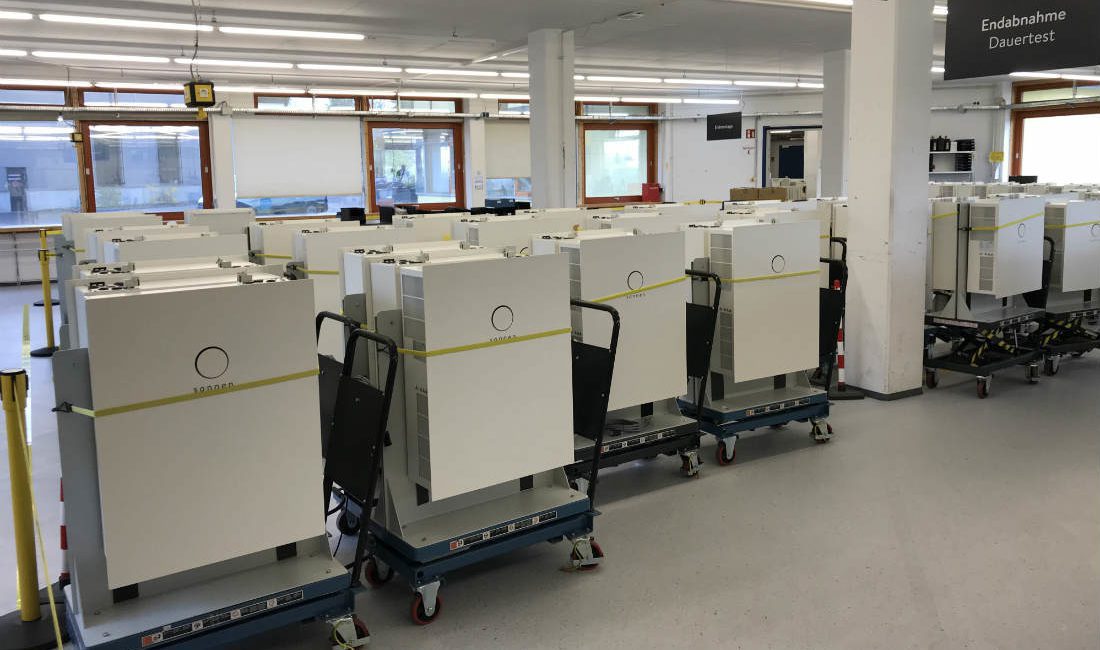Inside Sonnen Factory
Testing of the lithium-ion phosphate battery technology used by sonnenBatterie ecoLinx reveals its higher safety level compared to cobalt-based batteries used by Tesla Powerwall and others.
July 26, 2019

Depending on the battery power capacity, the weight of a sonnenBatterie ecoLinx can range from about 440 pounds to more than 900 pounds.
Sitting in the picturesque village of Wildspoldried, Germany, with surroundings that look like a picture postcard, the sonnenBatterie headquarters is using cutting-edge battery technology to build an intelligent energy solution that aims to change the world.
CE Pro got an exclusive inside look at the factory, which is about 75 miles from Munich. The facility has the renowned German efficiency you would expect to see.
The facility houses R&D, along with assembly and testing. The sonnenBatterie line of intelligent power storage/management products is in its ninth generation. The international product line is simple called the eco, while the product targeted at the U.S. market is called the ecoLinx.
The ecoLinx ntelligent energy storage solution works with smart home automation systems, including Crestron and Control4. Meanwhile, the international eco line also integrates with Loxone. The units can power a home with clean energy – managing energy usage throughout the day, providing instantaneous backup power in case of a grid outage and enabling homeowners to power their smart home with solar energy, day and night.
When the eco product first hit the European market in 2010, the lowest cost unit was $25,000. Today, an ecoLinx has an MSRP of $37,456 in the U.S. Employing safe lithium-ion phosphate battery technology as the basis of its ecoLinx home battery storage system, Sonnen’s 300 employees worldwide produce about 1,000 units per month.
Five years ago, the company could only build 100 units per month. It takes four hours to construct each unit, then two hours to charge each unit, and another 30 minutes to test.
Inside each ecoLinx is a bidirectional inverter, battery module and energy manager that enables it to intelligently work with home automation systems and controllable breakers to shed loads, charge an electric vehicle, appliance time shifting, and other functions. Many other storage systems only have a battery, according to Mathias Bloch, public relations at sonnen.
“That means an installer has to buy an inverter and find or create an energy management system. That makes it very complex for an installer. Our system is all-in-one,” he says. Bloch says there are 20 to 30 different choices for inverters and energy management controllers.
Depending on the battery power capacity, the weight of an ecoLinx can range from about 440 pounds to more than 900 pounds.
Internationally, sonnen offers eco units with or without a touchscreen; however, the ecoLinx U.S.-market product only comes in a version with a built-in touchpanel. .
According to Bloch, international customers overwhelmingly select eco units without displays because the units are primarily placed in basements or garages, and instead customers use a mobile app as the interface.
Lithium-Ion Phosphate Battery Technology
The lithium-ion phosphate battery technology is the real “magic” behind the product. The ecoLinx units, which have a 15-year/15,000-cycle warranty, produce no heat, unlike cobalt-based units like the Tesla Powerwall, which have an elaborate cooling system inside to reduce the heat output.
Inside sonnen’s battery lab, the company conducts tests on battery life, energy output, heat, etc. One test involves a machine that drives a nail through various battery types. Because the phosphate-based batteries have no oxygen, there is no explosion. The cobalt battery actually catches fire when nailed.
The phosphate batteries are cooler and safer, which is important when customers are putting this in their homes, according to Bloch. The trade-off is that the phosphate batteries are most expensive than their cobalt counterparts, but sonnen believes that trade-off is worth it.
Bloch is quick to point out that the company is constantly looking for new technology alternatives to the lithium-ion phosphate.
“We haven’t found one yet,” he quips.
The company will be at its third CEDIA Expo this year. Integrators are required to complete a one-day course to become certified installers. Once integrators install multiple systems, there is the potential to create “virtual power plants” that stabilize the power grid, helping to create the grid of the future.
Based on the technology advancements at play in the factory, it's no wonder that sonnen was purchased by Royal Dutch Shell oil company earlier this year.
CLICK HERE TO SEE MORE PHOTOS FROM CE PRO'S TOUR OF THE SONNEN FACTORY.
Source: CEPro (www.CEPro.com)
Author: Jason Knott